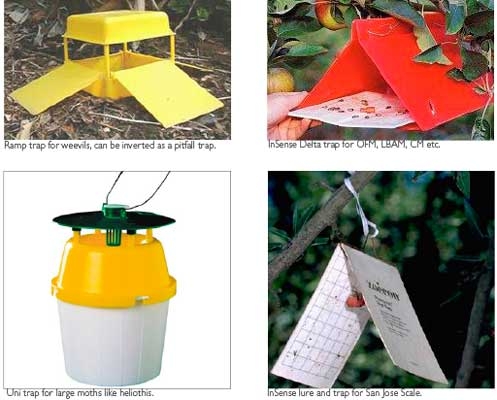Growers face a range of major insect pests—Queensland Fruit Fly in the east, Medfly in the west, Codling Moth, Oriental Fruit Moth, and LBAM.
Major and secondary pests (continued from last month)
Growers face a range of major insect pests—Queensland Fruit Fly in the east, Medfly in the west, Codling Moth, Oriental Fruit Moth, and LBAM.
Then there are a range of secondary pests: mites, scales, aphids; and cyclic pests that sometimes appear such as: harlequin bug, Carpophilus beetle, western flower thrips and apple dimple bug.
Where once they could almost all be managed with repeated cover sprays of broad-spectrum insecticides, now they are often managed individually.
Models
As we improve the pest control process, the key pests drive the pest management program—just as they always have.
Growers need to know when they show up, when they reach a stage that is vulnerable to control, when they start posing a threat to the crop, and when they stop being a threat.
The discovery that insects and diseases develop according to accumulated temperatures has allowed researchers to create models based on growing degree-day (DDU) accumulations.
While this is ‘old’ knowledge now, the Mills table for apple scab has been around for a long time, we do have new models for crop growing day degree harvest prediction, and risk assessment models for a range of diseases.
There is a wealth of accumulated knowledge and information on DDU, and is being developed for new pests worldwide.
Information on pest and disease models and DDU are easily found on the internet. But the knowledge of how to use this information, is in the pest traps in your orchard.
The whole internet experience is further broadened by hyperlinks to take you to other online resources—colour photos of bud development stages, fact sheets on the pests, sampling charts, ratings of the efficacy of various insecticides, remarks about effects on beneficial species, and re-entry and preharvest intervals. And it’s all in one place.
Traps are a key component
The traps are a key component of this knowledge.
Each year they give you the actual starting point of the pest’s lifecycle, and throughout the season the status of the pest in your orchard. This is a key point—accurate information about the pest in your orchard. This knowledge from the traps can then be used in the DDU models to predict grub hatch and the best time to spray, if required. Insect pest development stages are calculated from the DDU accumulations from the pest traps in your orchard, together with the information from weather stations and the Bureau of Meteorology weather data and forecasts.Growers can adjust the phenological stage to match what they observe happening in their orchards. More growers are putting in their own weather stations, connected to their own computers with line-of-sight wireless systems or mobile phones.Growers now fire up their computers and their web browsers before firing up the tractor and filling the sprayer.
See this article in Tree Fruit Dec 2016




















